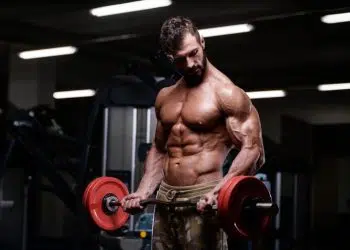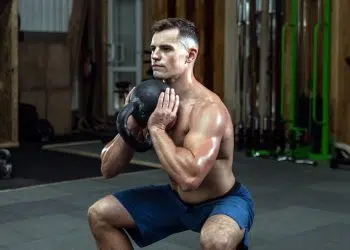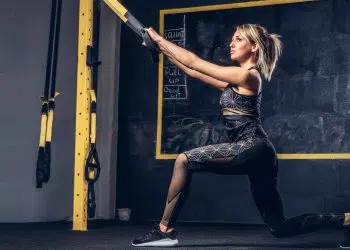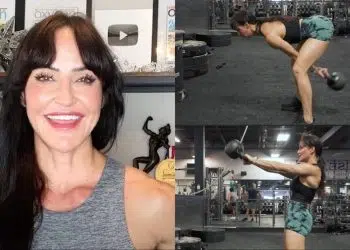It’s not your conventional strength-building exercise, however, movements such as the kettlebell windmill help to enhance many factors of your performance. It’s important to also focus on these types of exercises because they have total-body stabilization and flexibility benefits while also contributing to certain aspects of strength in upper and lower body muscles.
The kettlebell windmill technique builds strength and enhances the function of the shoulders, core muscles, and especially the obliques, glutes, hamstrings, and hips.
Doing this activity will have carryover to your other weight training movements, athletic activities, and is good for maintaining total-body health and fitness.
In this guide, we’ve explained how to do it correctly with tips, talked about the benefits you can expect and we included some variations and alternatives.
In This Exercise:
- Target Muscle Group: Total body
- Type: Strength, stability and flexibility
- Mechanics:
- Equipment: Kettlebell
- Difficulty: Intermediate/advanced
Kettlebell Windmill Muscles Worked
The kettlebell windmill works several muscle groups at once and below we’ve included brief descriptions of each body part involved.
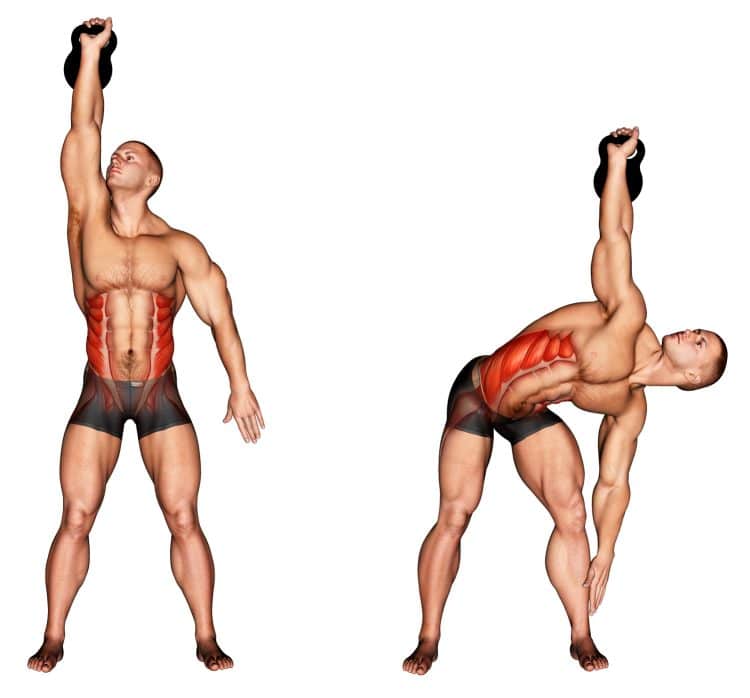
Level Up Your Fitness: Join our 💪 strong community in Fitness Volt Newsletter. Get daily inspiration, expert-backed workouts, nutrition tips, the latest in strength sports, and the support you need to reach your goals. Subscribe for free!
Iliopsoas
If you wondered how the spine connects to the lower body, it’s the iliopsoas group of muscles that include the psoas major and minor muscles and the iliacus muscle. Iliopsoas is the major muscle that flexes the hip. These muscles can work as a team or independently to perform certain functions including standing, maintaining posture, walking and running.
Obliques
The obliques are the neighboring muscles to the abdominals. The primary function of these muscles is to rotate or twist the torso, which is one aspect of performing the kettlebell windmill.
Tensor Fasciae latae
An integral part of the thigh anatomy, tensor fascia latae (TFL) contributes to the movement and stabilization function of the hip and knee. With the gluteus medius and gluteus minimus, TFL helps with the internal rotation and abduction of the hip.
Deltoids
The shoulder muscles are a crucial body part for upper limb movement especially kettlebell windmills that require recruitment of these muscles to balance a weight overhead. Also known as the deltoids, this three headed muscles flexes the arm in front of the body (anterior or front delts), lifts the arms up and laterally away from the body (lateral or side delts), and move the arms backward (posterior or rear delts).
Hamstrings
Formed by three heads on the backside of the thigh – semitendinosus, semimembranosus, and biceps femoris – the hamstrings muscles help us to perform hip extensions movements (standing from a squat) flexion of the knee (lying leg curls). Hamstrings also contribute during explosive movements such as sprinting and jumping.
Gluteus maximus
The butt is composed of a few different muscles such as the gluteus maximus, gluteus medius, and gluteus minimus. The jump squat engages this muscle primarily compared to the other glute muscles.
Extension and external rotation of the thighs is the name of the game when it comes to the butt muscles.
How To Do The Kettlebell Windmill
The kettlebell windmill is one of the more complex exercises but primarily because it requires decent flexibility and coordination. Here are step-by-step instructions to ensure you get the best results from performing this movement.
- In a roughly hip-width stance, pick up the kettlebell, clean it, and press it directly overhead while standing straight up.
- Rotate your feet 45 degrees opposite the hand you’re holding the kettlebell with. For example, after you press the weight overhead using your right arm, rotate your feet 45 degrees to the left. If holding it in the left hand, rotate your feet to the left.
- Before you do the movement, it’s important to understand proper body position. The knees should not bend as you want to keep them stiff as explained in the video below, and remember to maintain a neutral torso throughout the entire movement. There should be no rounding of the upper body.
- Now, while holding the kettlebell overhead and with your feet pointed in the proper direction, extend your non-working arm so that your hand is on the inside of your knee with the palm open and mirroring the position of the working arm that’s holding the kettlebell.
- Now you’re going to push your hips in the opposite direction of your feet and away from your center and simultaneously rotate your torso until you’re looking up at the kettlebell. The non-working arm will move down your leg toward your feet.
- Stop when you cannot descend any lower while maintaining the same exact form as detailed in each step prior. The knees should still be stiff while the torso should remain flat and not bent to try and go lower.
- Squeeze the glutes to stand back up in the original position keeping the feet in the same position and still holding the kettlebell overhead.
- Repeat the movement for the desired number of reps.
Here’s an excellent video tutorial.
Kettlebell windmill tips
- Ideally, you should clean the kettlebell into position. Kettlebell training is based on doing certain movements that effectively flow into the next and the clean is an essential component for many kettlebell exercises.
- Use a light kettlebell and perfect your form first if you’ve never done this exercise before.
- Keep the torso completely straight and do not bend it in an effort to reach a greater depth on the eccentric or lowering phase.
- Focus on hinging from the hips and do not bend the knees at all during the movement.
Kettlebell Windmill Benefits
There are a few key benefits to doing the kettlebell windmill.
Good for improving thoracic movement
One of the primary benefits of the kettlebell windmill is that it requires thoracic rotation which is great for improving upper back flexibility. A lot of us neglect these types of exercises that involve moving your body in ways that we’re not used to but it’s beneficial to everyday movement and function.
Hip hinge
Everyone should include hip hinge movements in their workout routine because hip strength and movement is crucial for so many things. From performing compound lower body exercises such as deadlifts and bent-over rows, to picking up things around the house and participating in athletic activities, you need to be strong in this area.
Shoulder stability
The shoulders are involved in pretty much every upper body movement both in the gym and out and are also a common area for injury. Training shoulder stability is a good idea for many reasons but especially to maintain the health of this ball and socket joint.
Also read: Get Bigger Shoulders Without Wrecking Your Joints
Great core move
This is a challenging core exercise that primarily recruits the oblique muscles through rotation but under resistance. Every part of the movement activates these muscles.
Unconventional
This isn’t something you’ll often see people doing at your gym and chances are you’ve never done it before. It’s much different than doing the common exercises but offers some great benefits that will help you to be better at the aforementioned movements.
Drawbacks
There aren’t many drawbacks to this exercise however we should point any out for those looking to try it.
Level Up Your Fitness: Join our 💪 strong community in Fitness Volt Newsletter. Get daily inspiration, expert-backed workouts, nutrition tips, the latest in strength sports, and the support you need to reach your goals. Subscribe for free!
You should be comfortable with using a kettlebell
Before doing this exercise, we recommend you have a little experience training with a kettlebell. It can feel awkward to its design especially if handling more than light weight, although we do suggest starting out light if you’ve never performed a similar movement.
Fortunately for you, we have lots of excellent content on kettlebell training so you can learn how to safely and effectively use this beneficial training tool.
Requires decent mobility
This exercise is most certainly not for everyone. For one it’s a little more complex than common exercise and secondly, it does require you to have some flexibility, mobility, and coordination.
Related: How and Why To Do The Windmill Exercise.
Kettlebell Windmill Variations
The kettlebell windmill is an excellent exercise that we recommend including in your workouts. However, we also really like these variations that offer unique benefits as well.
1. Dumbbell windmill
If you don’t have a kettlebell you could use a dumbbell instead. Oftentimes a dumbbell is more accessible so there’s no reason to not benefit from this beneficial exercise.
2. Turkish get-up
The Turkish get-up is an intimidation exercise because you really do have to be well-rounded to do it. It’s a complex, total-body movement that involves starting from a lying position on the floor and ending in a standing position while balancing a kettlebell overhead.
This variation also works a lot of the same muscles and compared to the kettlebell windmill, and it’s amazing for developing full-body coordination and stability.
Learn how to master the Turkish Get Up here.
3. Square stance snatch to kettlebell windmill
If you’re doing various kettlebell exercise variations, simply using a squared stance rather than turning your feet 45 degrees in either direction can make these transitions and exercise combos much easier.
You’ll simply stand with feet just slightly turned outward as you would if performing kettlebell swings. From here you can do snatch the kettlebell above your head and drop down using one fluid movement.
4. Kettlebell anyhow windmill
We love this one because you perform the windmill but also a biceps curl and therefore requires the use of two kettlebells. It’s definitely a more advanced exercise.
To do it:
- Set one kettlebell on the ground near the foot that is not on the same side as the arm holding the kettlebell.
- Clean the other kettlebell into position and then extend that arm overhead as you would if performing the basic kettlebell windmill.
- Then, shift your feet 45 degrees opposite the working arm.
- Slightly shift your hips back opposite your feet, maintain solid knees and a straight torso and hinge forward pushing the hips back.
- Pick up and curl the other kettlebell into your chest with the other arm.
- Now stand up, lower the kettlebell that you started the movement with into the curled position, shift your feet 45 degrees in the opposite direction and repeat the movement.
- Set the kettlebell down on the floor, pick it up and curl it and then repeat the exercise alternating from side to side.
Here’s a video example.
How To Program The Kettlebell Windmill Into Your Training Routine
This will depend on your goals, although it’s good to use a variety of training approaches.
But one of the best ways to program the kettlebell windmill is to do it at the end of a workout as a finisher to take advantage of its functional benefits. This way you get the compounds out of the way and then you can focus on your technique on this movement. It’s a great accessory movement to help improve your other lifts and is also good for doing supersets where you perform two exercises back to back with no rest in between.
Sets/reps
We’ve included the ideal sets and reps based on your goals.
Strength
- 3-5 sets of 3-5 reps
Low reps and heavier weights are best for building strength. Take a 2-3 rest in between to maximize your performance.
Hypertrophy
- 3-4 sets x 8-10 reps
To focus on muscle mass, stick to moderate reps with medium to heavier resistance. Rest 60-90 seconds between sets.
Muscular endurance
- 3 sets x 15-20 reps
This is best for athletes who play sports and CrossFit type training as it trains muscular endurance. Rest 60-90 seconds in between sets.
Wrapping Up
The kettlebell windmill is a great functional exercise that has many benefits and we recommend programming it into your training regime to enhance your overall fitness and workout performance. It’s a convenient exercise that targets specific areas often neglected and there are variations to make you even more well-rounded.
Interested in measuring your progress? Check out our strength standards for Lying Leg Curl, Clean, Snatch, and more.


